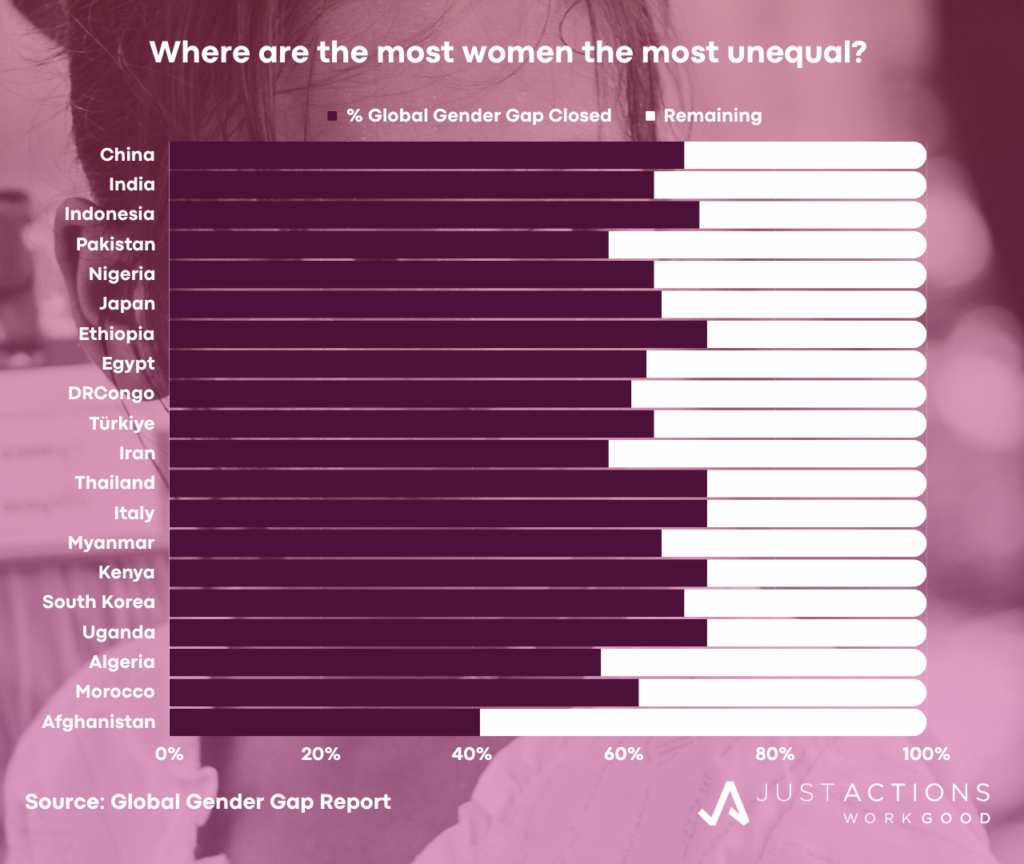Where are the most women the most unequal?
Where are the largest populations of the most disempowered women in the world? The twenty countries with the largest numbers of women and the lowest scores on the latest Global Gender Gap Report include nine in Asia, five in the Middle East, five in Africa, and one in Europe (see chart). Five are low-income (Ethiopia, the Democratic Republic of Congo, Afghanistan, Kenya, and Uganda), 12 are middle-income (China, India, Nigeria, Indonesia, Pakistan, Egypt, Türkiye, Iran, Thailand, Myanmar, Algeria, and Morocco), and three are high-income (Japan, South Korea, and Italy), according to the World Bank. Majority Hindu, Moslem, Christian, and Buddhist countries are all represented on the list, as are a variety of political systems and ideologies.
The Gender Gap Report measures national gender gaps across four measures – economic, education, health, and political power. Countries are scored on each of these four measures and given an aggregate score, ranging between 0 and 1, which reflects the percentage of the gender gap which has been closed. When countries reach 100% they are said to be gender equal. No country has reached 100%.
Among our twenty countries, Afghanistan scores the lowest in aggregate (41%) and several countries score 71%. Country performance varies according to each measure. For example, most countries score well on health – all score above 90% of the health gap closed – indicating that the lifespans of men and women are close to equal in most countries. Similarly, education scores are high across most countries indicating that male and female educational participation is very close to converging, with the exception of the Democratic Republic of Congo and Afghanistan.
However, scores on economic and political power are very low in all countries. This reflects the low labor market participation of women in these countries and the lack of women elected to Parliaments. Women’s economic participation in the economies of India, Pakistan, Iran, Algeria, and Afghanistan, with less that 40% of the gap to equality closed. The lowest scores of all are recorded for political power. No country has closed more than 50% of the gap and rates are below 10% for Nigeria, Japan, Iran, Myanmar, and Afghanistan.
There are several important takeouts here. First, women’s disempowerment is not necessarily connected to a country’s level of income or development. Second women’s disempowerment is not the preserve of any one religion or culture, or political system or ideology. All very interesting. But one of the most important takeaways from this list is that it tells us exactly where we should be targeting national, regional, and global “female-empowerment” investments to make the most difference for the most women, and ultimately for the world. There are three critical geographies, Asia, the Middle East, and Sub-Saharan Africa. And within those regions twenty critical countries, notable for the sheer number of disempowered women in their populations.
Where to target scarce gender-equity investments for maximum impact?
For investors and donors with gender-equity dollars to spend, the most urgent need is to encourage and support women to run for public office and to lead ministries and governments. This is an urgent need in all twenty countries. The second priority is for investments that increase women’s labor force participation and wages, especially in India, Pakistan, Egypt, and Iran. Educational investments to close gender gaps are still needed in the Democratic Republic of Congo, and Afghanistan, but health-related gender gaps have basically been closed in all countries.
When it comes to increasing women’s incomes, improving women’s health and education, and empowering woman as leaders in their own political systems, the women and girls living in these twenty countries should be a special focus of their own governments, the United Nations, companies, and civil society. Women living in the countries with the lowest gender gap scores have a special claim on international resources. If we are interested in targeting these resources to the largest groups of women who have the most to gain as a group, and the greatest to contribute to economic and human development, the Gender Gap Report analysis points to exactly what kinds of investments can have the greatest impact.
Updated January 2024



